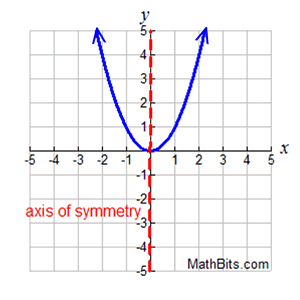|
Topics: maximum/minimum, symmetry and end behavior.
If looking for Intercepts, Positive/Negative, and Increasing/Decreasing, see Function Features.

 |
"Turning Points" |
A "turning point" on a graph is a point at which the graph changes from increasing to decreasing (it looks like a "hill"), or from decreasing to increasing (it looks like a "valley").
These turning points are referred to as relative (or local) maxima or minima. The designation of "relative" (or "local") tells you that this point may not be the largest (or smallest) value reached by this function. It is only a maximum (or minimum) "relative" to a small interval of the function surrounding this point. |
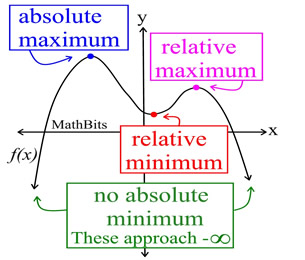 |
The one, true, largest (or smallest) value reached by the entire function is called the absolute maximum (or minimum), or the global maximum (or minimum).
There is some disagreement among textbook authors as to whether a relative maximum (or minimum) can occur at an endpoint (on a closed interval). Some references say "a relative max/min must occur in an open interval within the domain" (not at an endpoint), while others say "a relative max/min may occur at an endpoint." Some texts even introduce the terminology "endpoint maxima/minima" to avoid this issue. Note: An "absolute" maximum (or minimum) can occur at an endpoint.
A relative maximum may also be an absolute maximum. In the graph shown above, the absolute maximum is also a relative maximum.
The plural of maximum is maxima,
and the plural of minimum is minima.
Such references fall under the category of "extrema". |
|
|
For calculator
help with
maximum and minimum
click here.
|
|
|
We have seen that the graph of a parabola is a symmetric graph. The graph has an axis of symmetry over which the graph becomes a reflection (or mirror image) of itself.
We saw, when graphing parabolas, that knowing one portion of the graph let us quickly know how to graph its symmetric portion as well.
Not all graphs have symmetry. Of those functions that do possess symmetry, there are two types of symmetries that are popular: vertical symmetry and symmetry about the origin. |
|
If a graph possesses horizontal symmetry (such as a reflection over the x-axis), the graph is not a function.
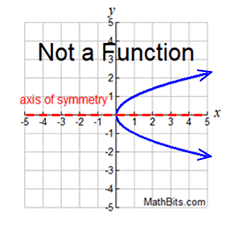
possesses both (x,y) and (x,-y).
|
A function graph may possess vertical symmetry (such as a reflection over the y-axis).
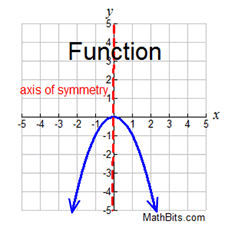
possesses both (x,y) and (-x,y).
|
A function graph may possess symmetry about the origin (0,0).
This is the same as a rotation of 180º
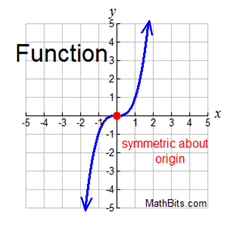
possesses both (x,y) and (-x,-y).
|
FYI: If a function is symmetric with respect to the y-axis (a reflection over the y-axis), it is called an even function.
If a function is symmetric with respect to the origin (a rotation of 180 degrees about the origin), it is called an odd function. NOT "all" functions are even function or odd functions.
 |
"End behavior" refers to the appearance of a graph as it is followed farther and farther in either direction (as the x-value gets very large or very small.
|
|
We have seen graphs with an arrow on either (or both) ends of the function indicating that the function continues "in the same manner" as the x-values continue to increase or decrease.
In the graph at the right, the arrow on the right end of the function tells us that as the x-values get larger and larger, the function (the y-values) will also get larger and larger. We say: "as x approaches positive infinity, f (x) approaches positive infinity." The "end behavior" is: as x → +∞, f (x)
→ +∞.
In a similar manner, the arrow on the left end of this function says, as the x-values get smaller and smaller, the function will get smaller and smaller. We say: "as x approachers negative infinity, f (x) approaches negative infinity."
The "end behavior" is": as x → -∞, f (x)
→ -∞. |
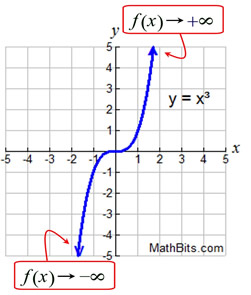 The arrow (→) is read "approaches".
The arrow (→) is read "approaches". |
Other possible situations:
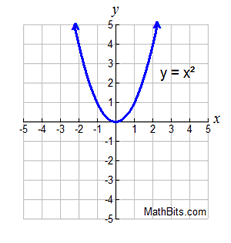
Both ends approaching positive infinity.
as x → +∞, f (x)
→ +∞
as x → -∞, f (x)
→ +∞ |
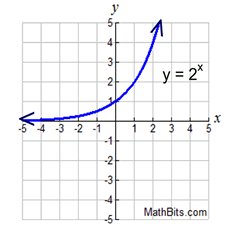
Right end approaching + infinity.
Left end approaching zero.
as x → +∞, f (x)
→ +∞
as x → -∞, f (x)
→ 0
|

Right end approaching + infinity.
Left end approaching three.
as x → +∞, f (x)
→ +∞
as x → -∞, f (x)
→ 3
|

"End behavior" typically addresses the behavior of a graph
as the x-values approach ± infinity.
 So, how do we discuss "end behavior" of a graph, when one end of the graph
STOPS at some endpoint, such as the case of a square root function?
How to deal with "end behavior" at an endpoint:
The function graph of the square root of x shows that as x approaches infinity, the function also approaches infinity. Nice.
BUT, as x approaches negative infinity, we have nothing, since the graph STOPPED at x = 0, and never approached negative infinity.
So how do we describe "end behavior" in this situation? |

as x → +∞, f (x)
→ +∞
as x → 0+, f (x) → 0 |
RE: End behavior at an endpoint:
In order to express something similar to "end behavior" when x is approaching an endpoint, we need to amend the notation to indicate the direction x is traveling on its journey to the endpoint. This direction will be a superscript.
(+) means x is approaching from the right side of the endpoint (coming from the right).
(-) means x is approaching from the left side of the endpoint (coming from the left).
| For this square root function, "end behavior" can be: |
as x → +∞, f (x) → +∞
as x → 0+, f (x) → 0 |
The second half says: "as x approaches 0 from the right side, the function f (x) approaches 0". |
|
You might ask, how about just saying as x → -∞, f (x) → 0?
Well, this idea is part-way correct, but is has a flaw.
Since we have no x-values on a square root graph to the left of zero,
we also do not have any y-values to the left of x = 0.
So, at x = -20, for example, is f (x) still in the process of approaching zero? Nope.
"As x → -∞, f (x) → 0" does not imply that f (x) will STOP after x = 0.
It actually implies that x will approach negative infinity.

These types of differing approaches will be further investigated in future courses.
|
For calculator
help with
determining
end behavior
click here.
|
|

NOTE: The re-posting of materials (in part or whole) from this site to the Internet
is copyright violation
and is not considered "fair use" for educators. Please read the "Terms of Use". |
|



